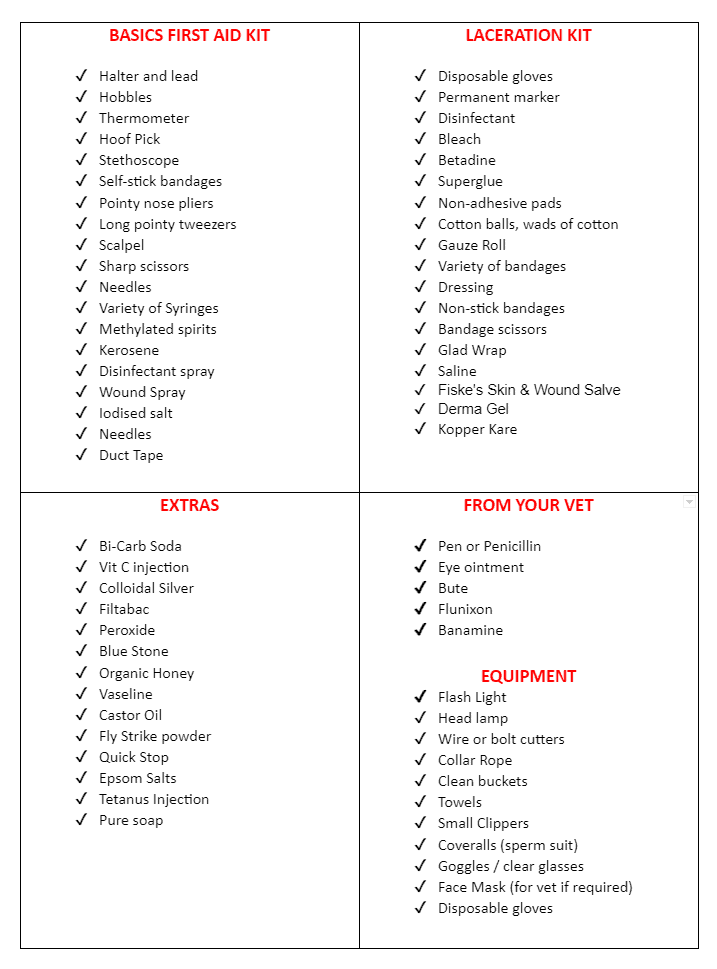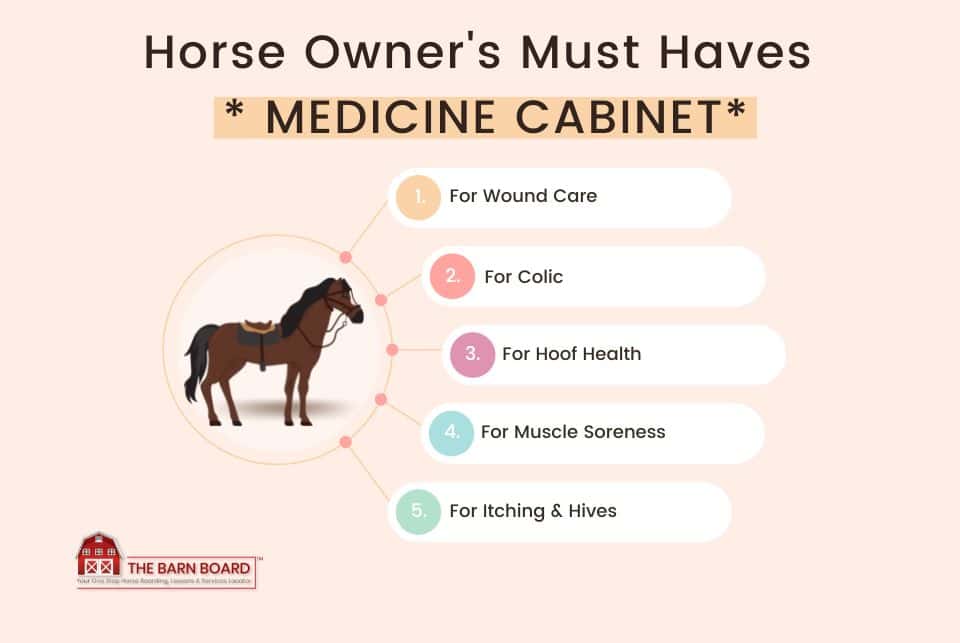When you are new to owning a horse or horses, it can be a daunting experience when they fall ill or hurt themselves and you are just not quite sure where to start.
Even the most experienced horses handlers find themselves wanting to tear their hair out on occasion. It is important to remember that you are not alone in the confusion, but it is also vital to always be prepared.
Always seek the professional opinion of your veterinarian if you are unsure or need confirmation on how to do something.
There are a number of basic must-haves, to have on hand at all times so we have put together a checklist for you to create your own Equine Medicine Cabinet Kit.
WOUND CARE
What type of care you can provide on the scene, is always going to be dependent on what type of wound the horse has sustained.
The most common wound types you are likely to encounter are:
Incised: a cut with clean, straight edges which may bleed frequently but generally heals quite quickly.
Laceration or tear: this is usually an irregular-shaped wound where the edges are torn and there are often skin flaps with a limited blood flow.
Abrasion: This is a superficial wound, much like a graze and it does not fully penetrate the skin.
Puncture: these wounds can be tricky to determine the damage, they often have a variable depth of soft tissue penetration but a small skin opening. Foreign material can be carried deep inside and trapped in the wound.
Penetration: where an object penetrates a body cavity with risk to the internal organs.
De-gloving: this is where the skin has been stripped from the limb or torso.
The following items to assist with wound care should be kept in your equine medicine cabinet at all times:
- Quick stop (for bleeding)
- Liquid Bandage
- Dust Wound Powder (wound caustic powder, goes hand in hand with scrubbing… scrub first then apply caustic powder … do not bandage if powder applied) — Farnam Wonder Dust Wound Powder for Horses
- You can mildly irritate the proud flesh by rubbing it vigorously with a dry gauze sponge until it begins to ooze, then apply the caustic powder. A common criticism of caustics is they may harm normal tissue, but this is not a concern if the area is kept dry. ***
- Fiske’s Skin & Wound Salve
- Derma Gel
- Betadine Iodine Solution (anti-septic helps prevent infections)
- Providine iodine sponge (scrub brush), these are optional but good to have on hand.
COLIC
This is a very stressful time for both horse and owner, and the severity is often unknown.
It is important to get to know your horse and its habits so that it enables you to be able to pick up on the subtle changes for when things might not be right.
Clinical signs depend on the cause of the colic and personality of the horse, however, there are many visual indicators that point towards your horse having colic.
- Loss of appetite
- Pawing
- Looking at the flank
- Lying down more than usual or at a different time from normal
- Lying down, getting up, circling, laying down again repeatedly
- Curling/lifting the upper lip
- Kicking up at the abdomen with hind legs
- Rolling up onto their back
- Stretching out
- Groaning
- Sweating
- Increased heart rate (normal is 28–44 beats per minute)
- Visible abdominal distention (appearance of being bloated)
- Less than normal to no manure production
- Diarrhea
- Foals may roll over onto their backs or grind their teeth and salivate excessively
Banamine is a muscle relaxant and is good to have on hand. In any case, it is important to call your veterinarian as soon as possible and ask for guidance on how to treat the symptoms.
THRUSH IN THE HOOF
What is it and how do I know if my horse has thrush?
It is a good idea, especially if you are riding/working your horse every day, to also clean out their feet before doing anything with them.
The conditions where you keep your horse is the first indicator as to whether or not that could be susceptible to thrush. Dirty, muddy conditions in a paddock situation or stalls that are not cleaned out regularly are a prime breeding ground for thrush. While water alone won’t be enough to cause it, moisture combined with dirt and muck makes room for a bacteria party in your horses’ hoof.
Thrush is a bacterial and fungal infection of the frog. The first tell-tale sign is a foul smell and black tar-like discharge, which often ends up on the end of your hoof pick if you are cleaning the hoof properly. If thrush is not treated early or the infection progresses too far, it can spread to the sensitive parts of the hoof.
What can I use to prevent Thrush?
- Kopper Kare
- Kerosene
- Bleach / water solution
To treat your horse’s hoof. Bleach is a super treatment for thrush, or as a general disinfectant for the bottom of the hoof. Dilute it in water first – say 1 cup of bleach to a gallon of water. Clean the horse’s hoof out well, and then slosh on some bleach.
QUICK TIP ON HOOF CLEANING: Get a wire brush. You can get them at a hardware store, or one of those big home improvement chains. They come in assorted sizes, down to about the size of a toothbrush. Spend a little extra time after you use a hoof pick and use the wire brush to remove loose dirt, debris, and even shedding sole and frog. Great hoof hygiene. Then bleach.
FOR ACUTE SORENESS, INJURIES (including Abscess) TO HOOF
It is a good idea to consult either your friendly local Farrier or your vet with regards to anything that comes into the acute category if you are still learning about the what is what and who is who of the horse world.
There is a very small window between being able to treat an ailment at home and possibly having a horse that is lame or crippled for some time.
How do I know if my horse has an abscess?
A horse’s hoof is not dissimilar to the human fingernail in that there is very little room for swelling, so when a horse has an abscess if not discovered or treated early on, the pressure can build up to a point where it causes severe pain and lameness.
Generally, with an abscess, a visual wound is not present, however, a severe abscess can produce swelling that carries on right up the horses’ leg. The heel bulbs, pastern, or coronary band may be swollen and often the hoof will feel warmer and you can feel pulses near the pastern.
Contact your vet or farrier immediately and have them assist you if this is your first time dealing with an abscess.
Items that are good to have in stock:
- Poultice
- Poultice Pad (good to cut hoof shape then vet wrap)
- Betadine solution / pads (diaper/sanitary pads)
- Duct Tape
FOR ACUTE SORENESS TO MUSCLES
Acute soreness to muscles can occur for a number of reasons. Horses like to gallop and kick, buck and play. It can be down to a simple oopsy in the paddock or can be caused from an old injury, or excessive riding and work.
Prevention is always better than a cure, in any case, so allowing your horse time to recover between heavy work sessions is always good for them. Having regular Chiropractic treatments and massage therapy are also excellent ways to keep your horse in tip-top shape.
Keeping a few of these items readily available may get you out of a sore situation and maintain your horses’ comfort until they recover.
- Liniment (and also poultice)
- Bute is NSAID should only be given under the direction of your vet and should not be used for extended periods of time.
- For swelling and heat leg: do sweat wrap
- Furazone to heat up then wrap w saran wrap then pillow then polo wrap
FOR ITCHING, HIVES, ETC.
Sweet itch, is often put down to a hypersensitivity to the bites of sand flies (midges). An allergic reaction caused by the saliva of biting insects which results in irritation and inflammation of the horses’ skin.
If you have ever dealt with your own horses or simply witnessed someone else’s horses displaying signs of the itch, it can be quite distressing for both the horse and owner.
The common causes of hives in horses are insect bites or stings, medications, and exposure to allergens. Other potential causes include vasculitis (inflammation of the blood vessels of the skin), food allergy, ringworm.
- Hemp Oil
- Witch Hazel
GENERAL EQUINE MEDICINE CABINET MUST-HAVES
- Hydrogen Peroxide
- Small blade, scissors
- Sponges
- Swabs
- Clean Towels
- Vet Wraps (Have several rolls)
- Duct Tape
- Poultice options
- Liniments (i.e. Absorbine Veterinary Liniment (Gel) )
- Epsom Salts
- Fly Spray
- Cotton Pads / Roll (to wrap bottom legs)
- Magic Cushion (hoof packing for after strenuous workout, training, jumping)



